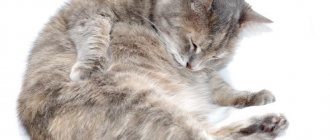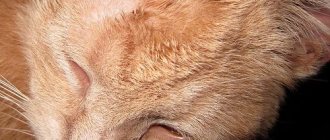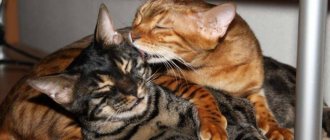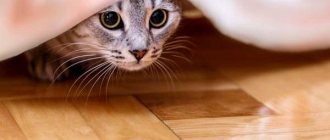A pregnant cat is very cute and scary at the same time. It’s scary because owners often don’t know how to prepare for childbirth and how to help their pet. Therefore, it is worth clarifying this issue.
For most people, cats are not just pets, but family members, and that is why owners constantly worry about their pets.
A very exciting and important moment for any owner is the birth of a cat. A cat is a wild animal by nature, so cats generally give birth without problems, but it is still necessary to prepare and be aware of possible difficulties and what needs to be prepared before this event.
How to prepare for the birth of a cat?
A cat does not need a birthing room like a human, but a special place will have to be arranged. A special box, which you can make yourself or buy at a pet store, is suitable as a “maternity box”. A cardboard box lined with newspapers or an old blanket will do just fine.
If the cat has access to the street, then in the last stages it is better not to let her out in order to prevent birth on the street. Also in the last days it is worth ensuring peace, absence of noise and other irritants and monitoring whether the animal’s condition changes.
In case complications arise during childbirth, it is better to prepare some supplies in advance; here is the necessary list:
- Any antiseptic
- Towels
- Treated scissors
- Pipette
- Sterile medical gloves
- Veterinarian phone number
The veterinarian should be chosen taking into account the possibility of a house call and preferably around the clock, because labor can begin at any moment. If it is not possible to call a veterinarian in a given locality, you can consult by telephone and follow the doctor’s instructions.
Cats and weather
Many beliefs are associated with cats and the weather. Since ancient times, people have tried to guess the vagaries of nature, focusing on the behavior of their pets. The following signs are associated with the weather:
- Sleeps soundly with his stomach turned up - for warm and hot weather
- Hiding his muzzle between his paws while sleeping means bad weather
- Curled up in a ball on my lap - it will be bitterly cold
- Sitting on the stove or radiator - to the cold
- Unfolds or licks its tail - wait for a snowstorm
- Hides his head - you can wait for a thunderstorm or rain
- He washes himself, licks his paws, strokes his head - there will be sunshine
- Licking the skin - most likely the day will be rainy
- If your ear scratches, it means it will snow or rain
- Scraping on glass, on a wall or floor - wait for the wind or blizzard
- Sharpening his claws on a table leg means a change in weather
- Sneezes - wait for precipitation
Of course, many of these signs are simple superstitions. But sometimes the behavior of animals is due to the fact that they better sense changes in the atmosphere that precede certain weather phenomena. For example, before a thunderstorm, a cat may become nervous. In the heat it tries to open up as much as possible, and in the cold it curls up into a ball to keep warm. Even scientists talk about predicting earthquakes based on animal behavior.
Cat behavior before giving birth: signs, symptoms, temperature
When the final stage of pregnancy approaches, the cat feels the approach of labor and special signs appear in its behavior.
The behavior of a cat before giving birth has the following signs, and the onset of labor is predicted by symptoms:
- The cat begins to look for a place to make a “nest” for itself.
- Immediately a couple of days before giving birth, the cat’s appetite begins to decrease, sometimes even to the point of losing it completely.
- Unusual character traits and habits may appear: for example, if a cat has always been independent and not very sociable, then before giving birth she may not leave the owner’s hands. Such sudden changes in habits and behavior are harbingers of an imminent birth.
- The cat becomes restless.
- The cat's mammary glands swell and increase in size.
If such signs of an approaching birth become noticeable, you should prepare and pay more attention to your pet, monitor how the cat behaves, what it does and how it feels.
It will be useful to read specialized literature or watch videos of cat births.
Optimal age for mating
Puberty in cats occurs between 7 and 9 months of the animal's first year of life. The onset of this period is difficult to miss. The pet exhibits new behavioral traits:
- Slowly walking on half-bent legs;
- Long and persistent meow;
- Constant demand for affection from owners;
- Purring accompanied by rubbing against various objects.
© shutterstock
At the same time, the first estrus appears in females. How quickly this happens, and how regularly it will happen in the future, directly depends on a number of factors, primarily on the breed. This phenomenon is accompanied by increased sexual arousal. By this indicator you can learn about sexual maturity and readiness for reproduction.
With the onset of heat, the cat begins to lick itself frequently and urinates profusely.
You can recognize this by interruptions in appetite. During the period of heat, the cat becomes more affectionate; she rolls and wriggles on the floor for a long time. At any opportune moment, she tries to sneak out into the street . It happens that some individuals during this period show aggression that is unusual for them. It will go away on its own.
The frequency of estrus occurs approximately every three weeks throughout the year. Sexual activity is observed year-round, but heightened desire can be observed in the period from February to March.
However, you should not organize mating before the animal is one year old. Early fertilization threatens the deflection of the spine and the threat of difficult childbirth.
Correct birth process
The first stage of labor begins with contractions as the uterus begins to open. After some time, the plug comes off, and gradually the contractions become more frequent and stronger.
At the second stage, the uterus is fully dilated and the first kitten begins to move along the birth canal. Kittens may be born with or without amniotic sacs. When a cat gives birth, it ruptures the amniotic sac and licks the kitten. After the kitten is born, the placenta comes out, and cats usually eat it.
It is important to remember the number of placentas delivered, and if there are fewer placentas delivered than kittens, you need to seek help from a veterinarian. Placenta remaining in the birth canal can lead to infections that are dangerous to the health and life of the cat.
A pregnant cat has diarrhea before giving birth, what should I do?
If a pregnant cat has any health problems, this will definitely worry the owner. Thus, pregnant cats often experience loose stools. But you should know that diarrhea in a pregnant cat a couple of days before giving birth is absolutely normal and natural. But you should not worry only if the animal has no other signs of illness.
Cat pregnancy, important nuances
Pregnancy in cats follows a specific cycle. According to generally accepted rules, cats that have value should be bred. If everything is done according to the rules, the mating is planned and registered in the breed club.
As practice shows, most inexperienced owners are faced with the pregnancy of their wards after the fact, without keeping an eye on the ward during heat. The first sign of pregnancy can be considered the absence of estrus, which should occur according to the cycle. Typically the cycle is 3–4 weeks. So, if your cat has not started meowing and calling for a male cat, it is worth analyzing whether she could have had contact with a male during her last heat.
If your cat does not have a breed value, in order to avoid pregnancy and the hassle associated with it, it is recommended to sterilize your pet before the onset of sexual heat. With a responsible approach, you will maintain the health of your pet and will not encounter the problem of “adopting” kittens.
According to a strange “tradition,” it is believed that a cat bears and gives birth to kittens without complications. In fact, planning pregnancy and caring for the expectant mother is of enormous importance. Like all living beings, cats experience serious stress during pregnancy and require increased nutrition and care. After the birth of kittens, many cats, especially purebred cats, may suffer from complications.
Note! In early pregnancy, the owner has a choice - medical abortion or castration of the cat. In the late stages of pregnancy, the owner will have to come to terms with and take responsibility for the life and health of the kittens.
Regardless of whether you wanted to get kittens or not, as soon as you find out that your cat is pregnant, she needs to be seen by a veterinarian. Before planned mating, both parents are vaccinated and free of parasites. If preventive measures were not carried out before mating, some of them can be carried out in the first trimester. Some types of parasites can infect kittens in utero, leading to serious postpartum complications or death of the entire litter.
If you have decided that your pet will give birth to kittens, you must take the veterinarian's advice with full responsibility. The sooner you balance the diet of the expectant mother, the higher the chances of giving birth to full-term kittens and maintaining the health of the pet.
Important! If your cat is giving birth for the first time, you should prepare for possible complications. Some animals suffer from postpartum eclampsia, and with prolonged labor, there is a risk of inflammation of the uterus.
In early pregnancy, you need to enrich your cat's diet with calcium and other beneficial microelements. Calcium deficiency is likely to lead to postpartum eclampsia. Make sure that while your cat has a good appetite, she remains active and mobile. Obesity is guaranteed to lead to complications during childbirth.
The first symptoms of pregnancy in cats appear approximately three weeks after conception. In the third week, you may notice that your cat's nipples are enlarged and slightly swollen. The glands acquire a more saturated, pink hue. These changes occur against the background of the pet’s normal activity. In the fourth week, you may notice the first roundness of your belly. If a cat is carrying 2–4 kittens, this sign may appear at 5 weeks. During pregnancy, swelling of the nipples becomes obvious by the 4th week.
If your cat is shaking before giving birth, what should you do?
There are two options to consider here:
- Before giving birth, cats breathe faster. Sometimes it becomes so frequent that the pregnant cat appears to be trembling or shaking.
- The cat is really shaking. This may be a banal reaction to a stressful situation, as well as a reaction to changes in body temperature. Therefore, if there are no other warning signs, there is no need to worry. However, if your cat has a high fever, loses consciousness, and also has unpleasant discharge from the genitals, you should immediately call a veterinarian, as this is a characteristic sign of complications during childbirth.
Normal pregnancy process, stages and timing
In a healthy animal, the process of pregnancy and childbirth occurs without the need for intervention or assistance. In purebred, small, problem cats, childbirth may occur with complications. In more developed countries, there is a special profession - zooobstetrician, a specialist responsible for the favorable course of childbirth, preserving the life and health of the mother and offspring. In “our realities,” all responsibility falls on the shoulders of the owners and general veterinarians.
On average, a normal cat pregnancy lasts 60–65 days, but the period can vary by 7–10 days depending on the breed and body composition of the expectant mother. Conventionally, pregnancy is divided into 3 stages:
- Mating – 3 weeks: after mating, the cat experiences swelling of the mucous membranes of the genital tract, but this does not guarantee pregnancy. Clear signs are observed from the third week: Drowsiness, decreased appetite and activity.
- Requires affection and attention.
- Vomiting (no more than 3 times a day, no longer than 2-3 days).
- Distinct pigmentation of the mammary glands - from light to bright pink.
- An enlarged uterus, which can be detected by a veterinarian by palpation.
- 4-6 weeks: Rapid growth of the “babies” and “rounding” of the cat. By week 6, the amount of fluid in the uterus increases, and the kittens begin to make their first movements.
- Kittens can be “felt” when gently palpated.
- The cat eats and sleeps more, otherwise behaves as usual.
- 7–9 weeks: Kittens are actively moving. The movements are clearly visible to the naked eye, especially if the cat is sleeping.
- Swelling of the mammary glands, release of colostrum.
- Some cats have a whitish vaginal discharge, which is normal.
- Increased anxiety and making a “den”.
Cat asks for attention
There are times when a healthy and well-fed cat meows for no reason. Why is this happening? Our pets, like little children, love attention. Animals vocalize when they want to be held, played with, or stroked.
Some cat breeds do not tolerate long absences from their owners. Left alone, they can meow for a long time and pitifully. Sphinxes have this character trait. It is not advisable to leave these animals alone for a long time; it will be very stressful for them. In this case, it is advisable to take a second cat into the house.
Diseases
Why does a cat meow for no reason for a long time, and it is impossible to calm her down? Most often this is due to poor health. In this case, you need to take your pet to the veterinarian as soon as possible. You should also carefully examine the animal and pay attention to the following signs:
- Screams when the stomach is touched. Such a symptom may indicate intestinal obstruction or helminthic infestation.
- Screams after a fall or walk. Most likely, the animal was injured. You need to carefully examine your pet, treat its wound and take it to the veterinarian.
- A plaintive meow near the tray. This often indicates urolithiasis.
- Old cats scream. In old age, many animals become more talkative. However, in some cases, loud meowing may be a sign of Alzheimer's disease. With this pathology, the animal is disoriented, constantly walks in circles and screams pitifully.
- Constant purring. Such sounds do not always indicate that the animal is experiencing pleasure. In some cases, this indicates cardiac problems. By making purring sounds, the cat is trying to normalize its heart rate. This manifestation can occur with tachycardia.
If you meow for no reason for a long time, you need to pick up the cat and try to calm it down. If the screams do not stop, then most likely your pet is sick.











